Peking University, September 19, 2022: Mr. Zhou Peiyuan (1902-1993) was a famous Chinese scientist in both fluid mechanics and theoretical physics, who has also been widely acknowledged to be an outstanding educator and social activist. His life was full of legends: he is regarded as the only known Chinese who once was guided by Albert Einstein in the study of relativity; he served as the president of Peking University between 1978 and 1981 and created China’s first major in mechanics at Peking University; during his lifetime he also endeavored for the development of higher education in China. This year marks the 120th anniversary of Mr. Zhou’s birth, and let us learn more about his legendary stories.
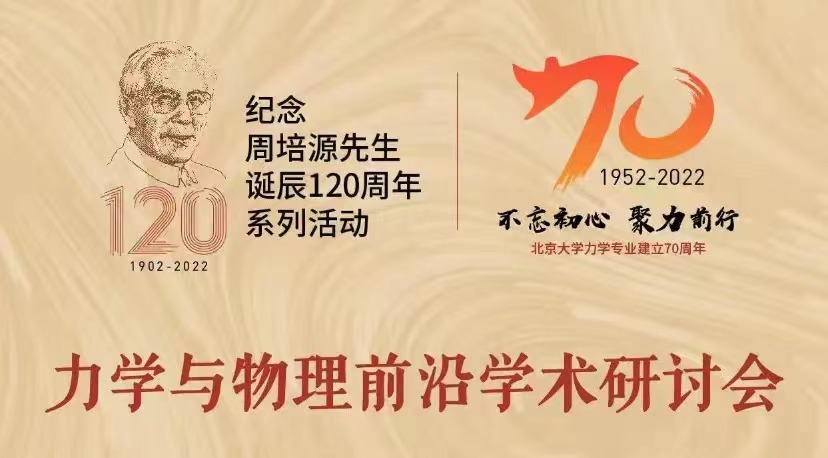
Decades-long effort to save the nation through science
In 1919, a group of students was forcefully expelled from the high school affiliated to St. John’s University in Shanghai. Among them was Zhou Peiyuan, who was then 17 years old and full of patriotic passion. As the wave of the May Fourth Movement swept across Shanghai, crowds of students stood up to support the patriotic causes of students in Beijing. Bravely stood in the forefront of the parade, Mr. Zhou was later punished as the “model” by the school to warn other students.
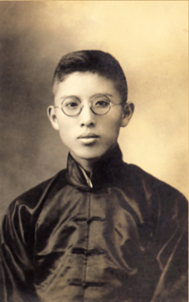 Mr. Zhou Peiyuan as a student in 1920
Mr. Zhou Peiyuan as a student in 1920
After his expulsion, Mr. Zhou spent his spare time reading newspapers. While studying by himself, he was also looking for a future path, and fortunately, he noticed the advertisement for admission to Tsinghua University in the corner of a page of his newspaper. Mr. Zhou still felt amazed by the opportunity years later, as he recalled, “The tiny piece of advertisement was published for only one day. What a coincidence that I happened to see it!”
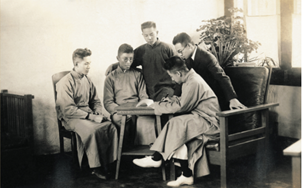 Discussing with classmates at Tsinghua University (2nd from the left: Mr. Zhou Peiyuan, 3rd from the left: Mr. Sun Li-jen, 1st from the right: Liang Sicheng)
Discussing with classmates at Tsinghua University (2nd from the left: Mr. Zhou Peiyuan, 3rd from the left: Mr. Sun Li-jen, 1st from the right: Liang Sicheng)
From Tsinghua University to institutes in other countries, the weakness of China urged Mr. Zhou to absorb as much knowledge as he could, in a bid to use continuous excellence to comfort his motherland. He once said, “I’m not smart but only hardworking. There’s a Chinese saying that (one should) amend stupidity by diligence, and that’s what I’m doing.” In just five years, Mr. Zhou received his bachelor’s and master’s degrees from the Department of Mathematics and Physics at the University of Chicago, and doctoral degree from the California Institute of Technology. Afterward, he went to Europe to conduct research in quantum mechanics, following two Nobel Prize laureates, Heisenberg and Pauli.
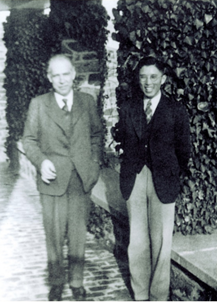 Group photo with Prof. Bohr (winner of the Nobel Prize) in Denmark, 1929
Group photo with Prof. Bohr (winner of the Nobel Prize) in Denmark, 1929
Zhou’s doctoral dissertation was entitled “The Gravitational Field of Objects with Rotational Symmetry by Einstein’s Theory of Gravity”, drawing from his experience as the only Chinese who has been engaged in relativity study alongside Albert Einstein for a long time. At that time, a saying was widely accepted in academia that “only 12 and a half people in the world really understand Einstein’s theory of relativity,” and that “half” denoted Mr. Zhou.
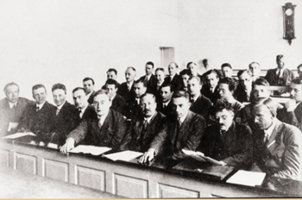 Scholars at Seminar on Einstein’s theory of Relativity (4th from the right in the 3rd row: Mr. Zhou Peiyuan)
Scholars at Seminar on Einstein’s theory of Relativity (4th from the right in the 3rd row: Mr. Zhou Peiyuan)
Notwithstanding fruitful achievements in relativity, Mr. Zhou Peiyuan resolutely turned his research interest to turbulence in the field of fluid mechanics, which had great value in face of China's War of Resistance Against Japanese Aggression (1931-1945). Mr. Zhou had his insistence: “The theory of relativity cannot serve the need of the War directly, but as a scientist, you must always try your best to save the country by means of science.”
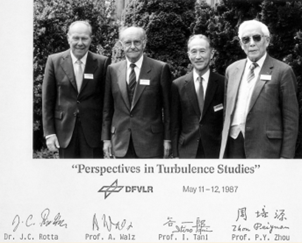 Big Four in the research of turbulence
Big Four in the research of turbulence
Three faculties teamed up to build department of mechanics
Under continuous gunfire, the National South-West Associated University (NSAU), a university jointly established by Peking University, Tsinghua University, and Nankai University during wartime, was relocated in Kunming, southwest China's Yunnan Province. ,In order to shield the students from the bombing by Japanese aircrafts, the professors were scattered in various suburban villages, far away from teaching buildings. It took several hours for Mr. Zhou to commute between home and campus, and his solution was riding a horse. He bought a horse and named it “Hua Long”, and then rushed to campus on horseback every day. For his special way of transportation, Zhou was teased in a friendly way by students and colleagues as “General Zhou.”
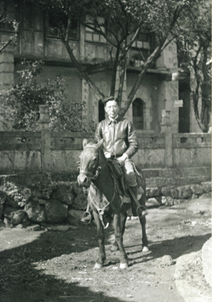 General Zhou on the horseback
General Zhou on the horseback
Although the horse had to be sold due to the rising prices, including the price of the silage, “General Zhou” was “galloping” all along his way to expand the territory of Chinese physics. During this period, he cultivated a large number of talents including Mr. Wang Zhuxi, Mr. Zhang Zongsui, Mr. Peng Huanwu, Mr. Hu Ning, Mr. Qian Sanqiang, Mr. Wang Ganchang, Mr. Duan Xuefu, Mr. Zhu Guangya, Mr. Zheng Zhimin, Mr. He Zuoxiu, Mr. Guo Zhongheng, Mr. Tong Fu, Mr. Wang Xuan, Mr. Wu Jike, and Mr. Huang Yongnian, to name but a few. They constituted the foundational scientists linked to the modern physics of China. Zhou’s teaching and his students and instructees contributed to China’s early nuclear and space projects. In fact, nearly half of the winners of the Two bombs and one Satellite Award were instructed by Mr. Zhou.
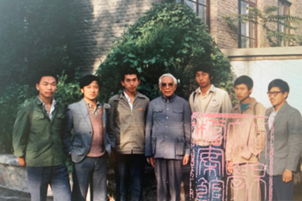 Mr. Zhou Peiyuan and his students
Mr. Zhou Peiyuan and his students
When talking about Mr. Zhou’s teaching style, his students all came up with the word “eclectic.” For example, he only wrote a few characters in big signature, and the difficult points in the lecture would be covered in precise words but the key points never be left out. Compared with his strict requirements on assignments, Mr. Zhou gave quite interesting questions in the final exam, such as discussing how monkeys climb pulleys, or solving the total distance of pigeons flying in trains (in opposite directions) back and forth. It could be seen that Mr. Zhou not only focused on the basics, but strongly promoted each student to do in-depth research within their abilities.
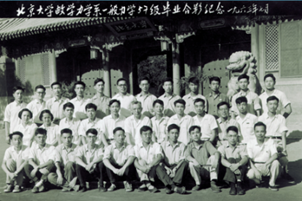 Group photo with 1957 graduates major in mechanics
Group photo with 1957 graduates major in mechanics
In 1952, Prof. Zhou Peiyuan established China’s first major in mechanics at Peking University, the predecessor of the current PKU’s Department of Mechanics and Engineering Science. The beginning was always tough: only three faculty members were employed and Prof. Zhou became the pioneer in charge of the subject of mechanics which at that time had only three instructors.
Nevertheless, Mr. Zhou’s contributions are far more than pioneering the area of physics, as he has been acknowledged to be the root of China’s scientific undertakings.
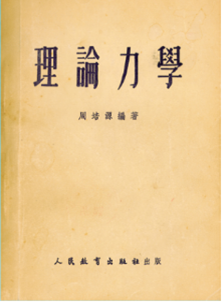 A textbook in mechanics edited by Mr. Zhou Peiyuan
A textbook in mechanics edited by Mr. Zhou Peiyuan
Latecomers can emerge as the frontrunners
After the founding of the People’s Republic of China in 1949, the development of science was appealed to be fully revitalized. In this sense, Mr. Zhou could no longer just focus on his duty in physics, as he devoted himself to those increasingly important responsibilities and historical missions endowed by China’s scientific community.
During his stay at the campus of NSAU, Mr. Zhou had no interest in social activities and politics; but at this point he assumed the role of a leader in the scientific community, accidentally and inevitably.
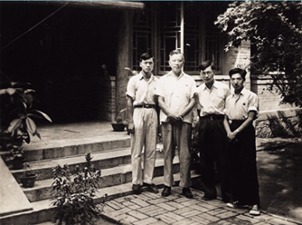 Group photo with students (2nd from the right: Prof. Shi Xuangang) at Yannan Garden in the 1950s
Group photo with students (2nd from the right: Prof. Shi Xuangang) at Yannan Garden in the 1950s
Living in Yannan Garden of Peking University for 30 years, Mr. Zhou tried his best to devise the development of higher education in China. At Peking University, Mr. Zhou served as the provost vice president and subsequently as the president. He was so approachable that there were frequent knocks on his door from teachers and students, and he always warmly received them. Mr. Zhou paid special attention to the scientific projects with its promotion and application at Peking University; for example, the famous laser phototypesetting system for Chinese characters invented by Mr. Wang Xuan became a succuss under his care.
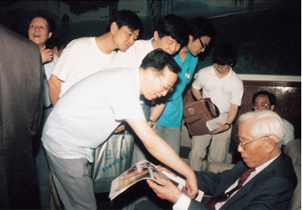 Prof. Wang Xuan presented a newspaper with color laser phototypesetting to Mr. Zhou Peiyuan in June, 1992
Prof. Wang Xuan presented a newspaper with color laser phototypesetting to Mr. Zhou Peiyuan in June, 1992
Facing waves of doubts from the outside, Mr. Zhou always acted as an vocal defender of the educational order and direction. He pointed out: “It’s ignorant and myopic to ignore the scientific education and basic theoretical research.”
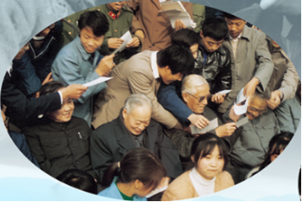 Group photo with the winners of the national physics competition
Group photo with the winners of the national physics competition
He engaged actively in the service of scientific and technological groups in China for 41 years, during which he was positioned as the secretary of the Secretariat of the China Association for Science and Technology (CAST), among many other leading roles. Mr. Zhou struggled to refute the noise of the abolishment of CAST, especially in a series of troughs, and he also carefully comforted his comrades who were at low ebbs in their research. In time of stability, Mr. Zhou was also a forerunner ahead of the times to cultivate the new generation of talents in scientific research, actively promoting the vigor of popular science in rural areas and facilitating the youth science and technology activities.
 Chairman Mao shaking hands with Indonesian scientists (1st from the left: Mr. Zhou Peiyuan, the 3rd from the left: General He Long)
Chairman Mao shaking hands with Indonesian scientists (1st from the left: Mr. Zhou Peiyuan, the 3rd from the left: General He Long)
For years, Mr. Zhou devoted himself to China’s opening-up and communication with the outside world, which helped to end the nation’s the academic isolation. Dubbed the “president of foreign affairs,” he visited dozens of countries and received many important leaders from foreign countries. More importantly, he took the lead in reaching an agreement with the United States on exchanging students and visiting scholars. It was a major scene in the establishment of diplomatic relations between China and the United States, which also paved the way for China’s scientific community to break through the blockade and engage with the rest of the world.
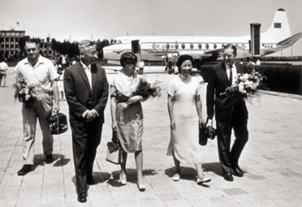 Mr. Zhou Peiyuan and his wife welcoming Australian scientists at the airport
Mr. Zhou Peiyuan and his wife welcoming Australian scientists at the airport
In 1973, Chairman Mao and Premier Zhou Enlai met with Yang Chen Ning, laureate of the 1957 Nobel Prize in Physics, accompanied by Mr. Zhou Peiyuan. Zhou mentioned that although he used to be the teacher of Yang, now he wanted to learn from his former student. Chairman Mao asked Zhou with a smile, “Are you behind now?” Mr. Zhou replied: “I’m behind the times now, but the latecomers can emerge as the forerunners one day.”
With much of the latter half of his life devoted to administrative and social work, Mr. Zhou was, to some extent, behind the time—as he put it. The “behindness,” however, was just limited to himself, and in a broader sense, he gave rise to the rapid development of China’s scientific community for decades to come.
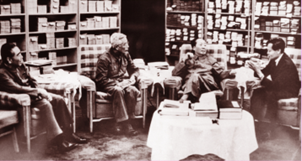 In 1973, Chairman Mao met with Yang Chen Ning, accompanied by Premier Zhou and Mr. Zhou Peiyuan
In 1973, Chairman Mao met with Yang Chen Ning, accompanied by Premier Zhou and Mr. Zhou Peiyuan
Treasures for the hereafter
This year is also the 70th anniversary of the the mechanics major at Peking University founded by Mr. Zhou Peiyuan. In the past 70 years, PKU’s mechanics has not only witnessed the hard work and outstanding achievements of generations of scientists, but also has seen the huge leap in China’s national economy and defense strength.
In addition to his legacy in the theory of turbulence, Mr, Zhou Peiyuan also left behind valuable spiritual wealth to the new generation of students majoring in mechanics. To inherit his spirit, Peking University has held a series of commemorative activities for Mr. Zhou including the launch of the China Mechanics Competition in Honor of Zhou Peiyuan (CMCZ) and the establishment of “Zhou Peiyuan College.” Patriotism, innovation, truth-seeking and dedication - Peking University will never forget the essence of Mr. Zhou’s thoughts, and will continue to and foster it in the construction of emerging engineering education.
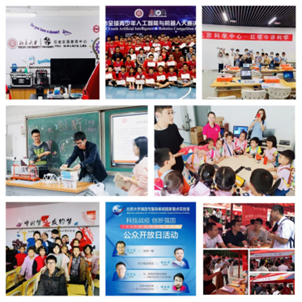 The popular science activities to the public held by PKU’s College of Engineering
The popular science activities to the public held by PKU’s College of Engineering
Written by: Fu Jiaqi
Edited by: Meng Bin
Source: PKU News
















